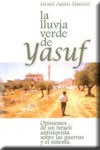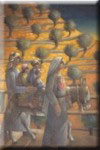Ladakh is a good place to get an understanding of the Tibetan problem, for Ladakh is also a part of Tibet ; there is one important difference: we never hear any bad news from Ladakh, though their situation is quite similar. Israel Shamir looks at Tibet over the border:
Buddha Nativity
By Israel Shamir
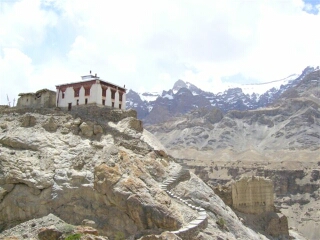
Long snake quickly moved down the mountain: hundreds
of monks ran along a curving paved path from the monastery at the top to the broad
polo grounds at the bottom, where the whole population of Leh had gathered to
celebrate the Buddha’s Nativity. Powerful, muscular monks in yellow hats
and orange robes were accompanied by peasants, city folk, urchins of sorts,
cars and cattle [on the upper photo: a Ladakh
monastery on the top, second photo: the monks]. The polo grounds with
flags and garlands, important folk sitting up on a long elevated tribune, and
performers queuing up recalled a typical May Day celebration in a provincial Soviet
town, though there were Lamas instead of Party officials. Actually, (ex-Soviet)
Tajikistan is not far from here – just over the impassable mountains, for
Leh, the capital city of Ladakh, is located in the upper reaches of the Indus
River, between the Himalayas and the Hindu Kush, squeezed between Tibet and
Kashmir, bordering on China and Pakistan, next to Afghanistan and Tajikistan. The
local people are fond of horseback riding, so the game of polo is not a foreign
invention to them, but rather a native game. Actually, the Brits learned it in
the southern slopes of the Himalayas , and
later on built polo grounds all over the Empire.
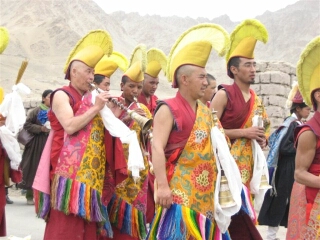
Once, Leh was an important place on an important road, but that was long time ago. Nowadays, Ladakh belongs to India , being part of the State of Jammu and Kashmir , its farthest-away part. The border with China and Pakistan having been closed, Leh is isolated by frontiers, troops, rivers and mountains. In the winter, Ladakh is practically cut off from the rest of the world. The road from Kashmir to Ladakh was opened in May, and it will be closed again at the end of September. It passes through awe-inspiring passes with romantic names: Zoji-la, Namika-la, Fatu-la, reminiscent of Shangri-la, beyond the snow-capped mountains. It is a scary experience to come to Ladakh from Kashmir – the Zoji-la mountain pass can frighten any atheist into saying a prayer. There is an image of the Virgin next to that of Buddha and to an Islamic mihrab at the top of the pass, and all of them are well attended by grateful travellers. However, the passes on the second road to India , the Manali road, are allegedly even worse, though one wonders whether that is even possible.
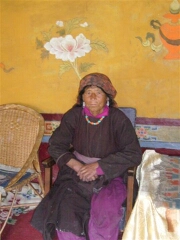 Ladakh, this vast, frozen and sparsely populated
desert, looks like the South Sinai , a barren
land with high mountains and huge military bases, mercifully enlivened by
temples and monasteries. There are trees in a few spots in the river valleys,
but otherwise this land is bare. Ladakhi towns are
tiny and rather pleasant. They have wonderful palatial houses with colourful
frescoes on the walls. Ladakh was once ruled by its own king, but not anymore.
The royal palace has been taken over by the government. Now the queen, the
widow of the last king, lives in an ordinary house one hour’s drive from
the capital Leh.
Ladakh, this vast, frozen and sparsely populated
desert, looks like the South Sinai , a barren
land with high mountains and huge military bases, mercifully enlivened by
temples and monasteries. There are trees in a few spots in the river valleys,
but otherwise this land is bare. Ladakhi towns are
tiny and rather pleasant. They have wonderful palatial houses with colourful
frescoes on the walls. Ladakh was once ruled by its own king, but not anymore.
The royal palace has been taken over by the government. Now the queen, the
widow of the last king, lives in an ordinary house one hour’s drive from
the capital Leh.
[On the third photo, a noble Ladakh lady in her palatial mansion].
I’ve been visiting a few monasteries in this most remote Buddhist country with an average altitude of 10,000 feet. Though religions differ, man’s need for communing with God remains a constant. Buddhists – like Orthodox Christians – strive to achieve this perfect union with God; they call it enlightenment while we call it theosis or deification. Their monasteries are full of icons they call tanka. Their night chants begin at the same time the monks of Mt Athos start their morning prayer, and last very, very long. There are differences, too: though we admire and venerate our spiritual teachers, we never worship a living person like they do. There are more photos of the Dalai Lama in the monasteries than there were portraits of Stalin and Mao in Russia and China . To make the comparison stick, there are also copies of his collected works in so many languages.
Once there were many monks and monasteries; huge reliefs of the Buddha still embellish the land, as well as their mani walls made of ritually inscribed flat stones. But the attraction of monkhood has faded notably. I stayed in Lamayuru, one of the biggest monasteries in Ladakh. It is a vast complex with dozens of houses and stupas, big and small – but there was only one resident monk. I was told that a few more were scattered throughout the area, helping with the harvest and teaching children. In the old days, the monks taught children in a monastery school. Now the Indian government provides schools, so children do not have to go to monasteries, though monks still teach. Still, the literacy rate here is below 25%, while in neighbouring Tibet it is 95%. Moreover, Tibet is accessible all year round even by train, while Ladakh is not.
Ladakh is a good place to get an understanding of the Tibetan problem, for Ladakh is also a part of Tibet, and the native population is kin to the Tibetans. Ladakhis and Tibetans understand each other almost as well as people from different parts of Ladakh understand each other.
There is one important difference: we never hear any bad news from Ladakh, though their situation is quite similar. Both are not independent. While Tibet belongs to China , Ladakh belongs to India . Whereas in Tibet , money and business is mainly in Chinese hands, in Ladakh business, trade, hotels, tourism are in Indian, mainly Kashmiri hands. The reasons for the differential treatment lie elsewhere: India is more compliant with the West than China , and that is why China is attacked. If Ind ia were to become equally ‘stubborn’, we should soon be hearing about mistreated Ladakhis, too.
The people of Ladakh and of Tibet surely have their problems but these problems are mainly due to “progress” – the State ( China or India ) took over the role once performed by the monasteries. Nowadays, roads are repaired, schools run, and taxes collected by the state, not by monasteries. The monasteries have lost their position as feudal seigniors. Naturally the monks are not happy about it; but the same can be said in France or Russia : even there, the monks would like to revert to less hectic times. Tibet is just the only place that the Western media brings us the opinion of the monks as a valid one rather than as curiosity.
The native people haven’t sufficient capital, connections or experience to compete with the Indians and the Chinese in trade and business. Native culture is being eroded by globalisation both in Tibet and in Ladakh (as it is in your home town), but only in Tibet we hear it called “cultural genocide”.

On a wall in Ladakh I spotted this sticker attached to … Pepsi Cola sign, apparently the very opposite to “cultural genocide”. Indeed the present attack on China because of its “cultural genocide” in Tibet is a cynical media manipulation. Tibetans actually do better in Tibet than Ladakhis in Ladakh, and with departure of communism, even this reason evaporated.
If ever Tibet will become ind ependent, it is likely to tear away the Indian territories of Ladakh and Himachal Pradesh, as the native population is akin to Tibetans, and connected to Tibet by blood, marriages, customs, language and religion. This is a strong argument against giving too much support to the Tibetan cause: changes of status quo are bloody and violent and usually are connected with ethnic cleansing.
The Tibetans in Himachal Pradesh and Ladakh describe themselves as ‘refugees’, but after all they live in close proximity to their old homes, among their cousins and at their own choice. They are as much refugees as the Irish in Liverpool . They should make their choice: go back to Tibet or become naturalised in Ind ia . Apparently both possibilities are open to them. Chinese Tibet is not some dreadful place of communist torture chambers, and they can go back without fear for their lives. Instead, they take CIA money to despoil the walls of Leh with their nasty anti-Chinese slogans and with their cheap propaganda in English aimed at foreign tourists. I asked some Tibetan refugees: would they return to Tibet ? Yes, we would, they said, if the Dalai Lama would return as well, and this is not likely to happen soon.
Tibetans are just one ethnic group among many others living in the area. Their independence would cause other small groups claim their ind ependence, as it happened in the most recent case of Georgia and Ossetia . Ind eed, if Kartvelis can become ind ependent of Russia , why Ossetia can’t become independent of Georgia? If Tibetans may become independent of China, why Ladakhis can’t become independent of India? Promotion of ‘national independence’ is a deadly game, it always was, and it is better to stop it.
Let the Tibet ans and the Ladakhis worship at their monasteries and improve their lives, let the Dalai Lama concentrate his efforts of the real Buddhist goals, i.e. seeking Nirvana, while leaving the dreams of full cultural (let alone political) ind ependence where they belong – in the Dream Kingdom .








